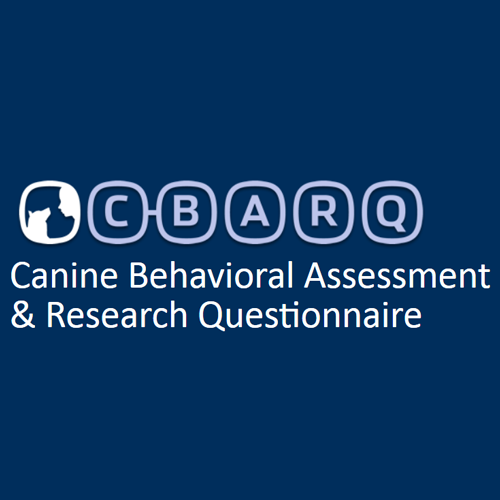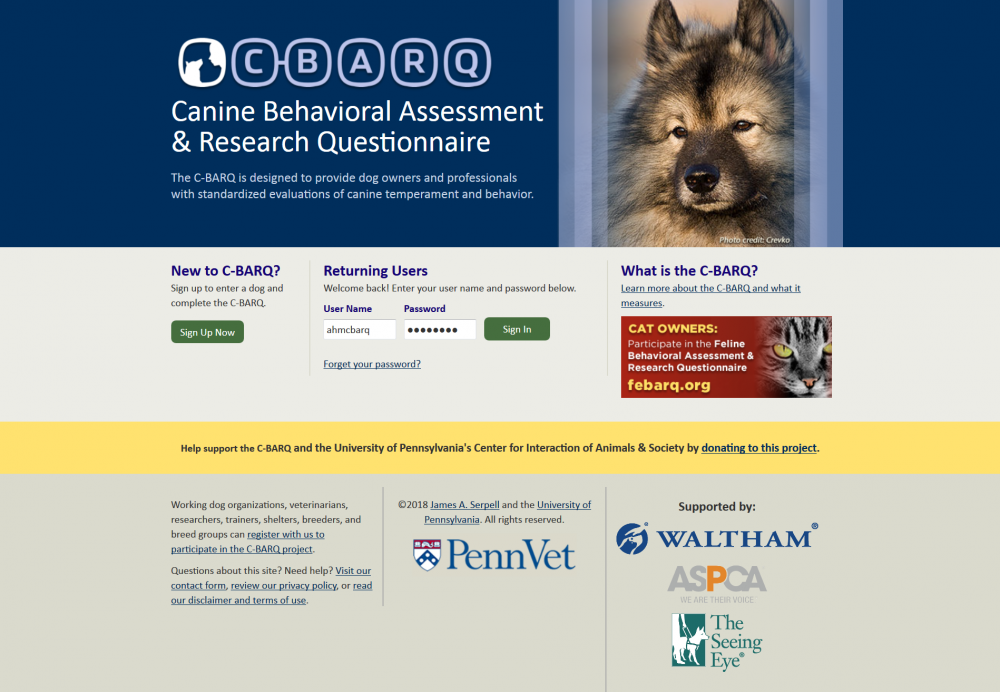Breeding for Behavior | Mentality | Instinct
10 articles in this category
-
 You may want to access the summary of each of the talks contained in the Rapporteur-Wrap-Canine-Behaviour-and-Geneticsweb.pdf. In this presentation these two accomplished veterinary researchers cover the major points from each presentation. In their summary, they highlight the key points from the meeting, organized into issues and topics that were identified as needing further international cooperation and collaboration. Their first 4 points (below) are similar to those needs
You may want to access the summary of each of the talks contained in the Rapporteur-Wrap-Canine-Behaviour-and-Geneticsweb.pdf. In this presentation these two accomplished veterinary researchers cover the major points from each presentation. In their summary, they highlight the key points from the meeting, organized into issues and topics that were identified as needing further international cooperation and collaboration. Their first 4 points (below) are similar to those needs- An exciting, multidisciplinary event has just concluded in London, UK. Attended by renowned scientists and researchers from fields including genetics, behaviour, epidemiology, animal breeding and more as well as veterinarians and behavior practictioners from around the world, this event was designed to promote international awareness, interest and collaboration. Behavior of dogs is a complex interplay of genetic and environmental - dog and human factors and can best be addressed by interaction and collaboration. Information on topics and presentations is now available on their site: Canine Behaviour and Genetics Presentation PDFs (website and presentations are not currently available 5-11-2017) And further discussion below ... This article was edited on 5-11-2017; please note, some referenced content/links are no longer available.
- 0 comments
- 2,915 views
-
 BBonnett Poster A0 Behaviour.pdf
BBonnett Poster A0 Behaviour.pdf- IPFD and DogWellNet.com hope to provide a platform for international collaboration - on many topics related to dog health, well-being and welfare - and we are reaching out to various groups to participate. As presented another article in this section: Selection of Behavioural Characteristics Prof.'s Peter Friedrich and Erling Strandberg gave thought provoking plenary presentations and then a group of about 20 individuals from numerous countries met to discuss the needs for international collaboration on behaviour at the 2nd International Dog Health Workshop (IDHW) in Dortmund, Germany. DogWellNet.com was launched at the 2nd IDHW and a major focus of the weekend was to determine how this new platform of the IPFD could support international collaboration. As a follow up to that meeting, we are presenting a poster at the Canine Behaviour and Genetics conference in London 26-28 June 2015. In addition to outlining the Mission and Goals of the IPFD, including the IDHWs we hope to stimulate interest from those interested in behaviour to join in efforts to enhance international collaborative efforts. We are in the process of inviting experts to join us on DogWellNet.com and to share or direct us to pertinent material. We are setting up a Forum to stimulate discussion on these important topics and to plan a way forward. If we can show a collective international will for international collaboration, hopefully we can find financial support. So many are doing great work. It is not always easy to find this material - especially for breeders and breeding advisors at breed and kennel clubs. DogWellNet.com offers a platform that is ready to help bring together stakeholders from many areas of the dog world. Please see the attached draft of the poster attached to this article. See especially the Action Items.
- 0 comments
- 2,390 views
-
 Breeders are the ones responsible for combining the genetic material of the dog world. The very best breeders try to bring it all together. However, it is an increasing challenge with an ever-burgeoning number of possible tests they could do on their dogs and in light of our still limited knowledge when it comes to, e.g. prevalence and risk of diseases, conditions or behaviours, specifics of inheritance of, especially, complex traits and the uncertainties of the impact of environment, in its bro
Breeders are the ones responsible for combining the genetic material of the dog world. The very best breeders try to bring it all together. However, it is an increasing challenge with an ever-burgeoning number of possible tests they could do on their dogs and in light of our still limited knowledge when it comes to, e.g. prevalence and risk of diseases, conditions or behaviours, specifics of inheritance of, especially, complex traits and the uncertainties of the impact of environment, in its bro- Questions that need to be addressed:
- In what ways are behaviour / temperament / instinct related to dog health and welfare?
- Why should behaviour be an integral part of a website devoted to 'dog health, well-being and welfare'?
Dog behaviour experts and researchers have their own organizations - why participate with IPFD and DogWellNet.com - i.e. with a broad group of stakeholders including breeders, breed and kennel clubs, breeding advisors as well as veterinarians and researchers in other fields?
- What are challenges to international collaboration on behaviour?
- Do we know enough about breed-specific differences in behaviour? (see article in Peer Reviewed Research section).
- How should information about behaviour be integrated into breeding decisions?
- 0 comments
- 3,262 views
-
 Dogs are unusual compared to other animals in how they cooperate and communicate with humans, and differences between individual dogs in these abilities can help inform how we select, breed, and train working dogs. Dr. Hare presented research comparing dogs to other species and data from the largest studies of dog emotion and cognition to reach his conclusions. (Source: Embark Veterinary)
Dogs are unusual compared to other animals in how they cooperate and communicate with humans, and differences between individual dogs in these abilities can help inform how we select, breed, and train working dogs. Dr. Hare presented research comparing dogs to other species and data from the largest studies of dog emotion and cognition to reach his conclusions. (Source: Embark Veterinary)- Dr. Brian Hare is a core member of the Center of Cognitive Neuroscience, a Professor in Evolutionary Anthropology, and Psychology and Neuroscience at Duke University. His Keynote Address, Is Your Dog a Genius?, was delivered at the Embark Canine Health Summit on 15 February 2021.
- 0 comments
- 1,352 views
-
 Doglogbook has been designed by animal welfare scientists at the University of Sydney, Faculty of Veterinary Science to be a dog’s new best friend, helping ensure optimum quality of life and happiness – from puppyhood through to old age to assist with difficult end-of-life decisions. To learn more about the free Doglogbook App go to: https://www.doglogbook.com/ The App is available from Google Play and Itunes. Also see rela
Doglogbook has been designed by animal welfare scientists at the University of Sydney, Faculty of Veterinary Science to be a dog’s new best friend, helping ensure optimum quality of life and happiness – from puppyhood through to old age to assist with difficult end-of-life decisions. To learn more about the free Doglogbook App go to: https://www.doglogbook.com/ The App is available from Google Play and Itunes. Also see rela- September 2016
News from PAUL McGREEVY | Professor
Faculty of Veterinary Science
THE UNIVERSITY OF SYDNEY IT to pups’ rescue!!!
The University of Sydney recently launched a world-first app that will not only help owners help their dogs be happier and healthier, but could also play a life-saving role by teaching young dogs to behave better.
- 0 comments
- 2,582 views
-
Per Arvelius - Canine Behaviour & Genetics
Per Arvelius - Canine Behaviour and Genetics Meeting
London
26-28 June 2015Summary
1. Dog behaviour shows genetic variation and can therefore be improved by breeding
2. Modern techniques for estimating breeding values have a huge potential to increase genetic improvement of dog behaviour
3. Behavioural measurements should (usually) be objective and neutral, and summarized into composite traitsGenetic Evaluation of Behaviour in Dogs (external link - access) Doctoral Thesis
" A dog's behavioural characteristics are important for the dog, for the dog owner and for society as a whole. Behavioural traits can be changed by breeding, but to be effective when selecting breeding animals, good methods for measuring behaviour are essential. "
"The overall aim of this thesis was to investigate the prospects for improving dog behaviour by breeding. Dog breeders would potentially benefit substantially in terms of faster genetic progress for important behavioural traits, if modern methods for genetic evaluation were applied. For this to function well, it is essential to have good methods for measuring the traits of interest. In this thesis, a number of dog behavioural measurement methods were evaluated for their potential to be used for genetic evaluation, and with the purpose of advancing our understanding of factors affecting the usefulness of behavioural measurements for breeding purposes."
- Per Arvelius -- Genetic Evaluation of Behaviour in Dogs
- 0 comments
- 2,093 views
-
 The authors present an introduction, discuss "What is a Breed"; review "Measuring Breed Differences in Behavior" and present the results of a recent study: "As well as varying greatly in size, shape, and behavior, dog breeds also differ in popularity, with some breeds (e.g. Labrador retriever) maintaining rather consistent levels of popularity over time while others (e.g. Irish setter) have been subject to relatively sudden and rapid fluctuations in popularity (Herzog 2006). One possible explana
The authors present an introduction, discuss "What is a Breed"; review "Measuring Breed Differences in Behavior" and present the results of a recent study: "As well as varying greatly in size, shape, and behavior, dog breeds also differ in popularity, with some breeds (e.g. Labrador retriever) maintaining rather consistent levels of popularity over time while others (e.g. Irish setter) have been subject to relatively sudden and rapid fluctuations in popularity (Herzog 2006). One possible explana- As outlined in the plenary talks, conclusions and Action Items (related to Selection for Behaviour Traits) developed at the 2nd International Dog Health Workshop there is a role for various types of instruments, tests, evaluations and approaches, although it is cautioned that application of test results must be breed-specific and related to breeding goals. (See also discussion in our Forums). Here are presented excerpts from a recent review and presentation of a study that addresses issues of breed-specific behavior evaluation and understanding. It is from: Chapter 2
Dog Breeds and Their Behavior
by James A. Serpell and Deborah L. Duffy
in
A. Horowitz (ed.), Domestic Dog Cognition and Behavior
DOI: 10.1007/978-3-642-53994-7_2, Springer-Verlag Berlin Heidelberg 2014.Abstract
"Domestic dogs display an extraordinary level of phenotypic diversity in morphology and behavior. Furthermore, due to breeding practices introduced during the nineteenth century, these phenotypic traits have become relatively ‘fixed’ within breeds, allowing biologists to obtain unique insights regarding the genetic bases of behavioral diversity, and the effects of domestication and artificial selection on temperament. Here we explore differences in behavior among the 30 most popular dog breeds registered with the American Kennel Club based on owner responses to a standardized and validated behavioral questionnaire (CBARQ). The findings indicate that some breed-associated temperament traits (e.g. fear/anxiety) may be linked to specific gene mutations, while others may represent more general behavioral legacies of ‘ancient’ ancestry, physical deformity,and/or human selection for specific functional abilities. They also suggest that previous efforts to relate dog breed popularity to behavior may have failed due to the confounding effects of body size."
- 0 comments
- 3,297 views
-

- C-BARQ is a behavior assessment tool from the University of Pennsylvania.
 More info...
EXCERPT... information on C-BARQ (February 2018) from https://scistarter.com/project/1035-C-BARQ-and-Fe-BARQ
More info...
EXCERPT... information on C-BARQ (February 2018) from https://scistarter.com/project/1035-C-BARQ-and-Fe-BARQ
.....................................Presented By University of Pennsylvania Goal Standardized evaluations of dog and cat temperament and behavior Task Complete a questionnaire about your dog or cat Where Online only Description The C-BARQ (or Canine Behavioral Assessment and Research Questionnaire) is designed to provide dog owners and professionals with standardized evaluations of canine temperament and behavior. The Fe-BARQ is a new behavioral survey instrument for cat owners. The current versions each consist of 100 questions describing the different ways in which dogs and cats typically respond to common events, situations, and stimuli in their environment. They are simple to use, and can be completed by anyone who is reasonably familiar with their pet's typical, day-to-day behavior. On average, they take about 15-20 minutes to complete. The aim of this project is to collect behavioral data on pet dogs and cats from citizen scientists all over the world. To date, we have collected more than 40,000 records for more than 290 different breeds and mixed breeds of dog and about 5,000 records for cats, but the more owners who contribute to the project, the better. The main goal is to understand variation in temperament and behavior dogs and cats, and the causes of canine and feline behavior problems. The C-BARQ and Fe-BARQ are also available to veterinarians, behavior counselors, researchers, shelters, breeders, and working dog organizations with an interest in evaluating dog and cat behavior. How to Join Sign up at http://vetapps.vet.upenn.edu/cbarq/ and complete the evaluation for your dog(s) or cat(s)Website http://vetapps.vet.upenn.edu/cbarq/ Ideal Age Group High school (14 - 17 years), College, Graduate students, Adults, Families, Seniors Ideal Frequency Just once Average Time Less than an hour Spend the Time indoors Type of Activity Exclusively online
- 0 comments
- 5,671 views
-
 Some of these challenges have been included in discussions at the International Dog Health Workshops, where there has been an attempt made to define the issues that should be addressed among international collaborators. Selection for Behavioural Traits as discussed in plenary sessions at the 2nd International Dog Health Workshop Dortmund, Germany: Plenary presentations (Saturday 14th February 2015) Prof. Peter Friedrich: Selection for Behavioural Traits Prof. Erling Standberg: New de
Some of these challenges have been included in discussions at the International Dog Health Workshops, where there has been an attempt made to define the issues that should be addressed among international collaborators. Selection for Behavioural Traits as discussed in plenary sessions at the 2nd International Dog Health Workshop Dortmund, Germany: Plenary presentations (Saturday 14th February 2015) Prof. Peter Friedrich: Selection for Behavioural Traits Prof. Erling Standberg: New de- As soon as we enter any discussion about assessing behavior we are immediately hit by several challenges:
- Terminology: behaviour, personality, temperament, instinct... or ??
- Are we interested in evaluating an individual dog? Or are we trying to determine aspects of a breed?
- If we are doing a 'test' what is the purpose?
- for the general interest of an owner?
- because of a behavioural 'problem' or clinical condition?
- to assess an individual dog for fitness - in general or for a specific activity (e.g. therapy dog)?
- to determine whether the dog should be bred?
- to evaluate heritability of traits within a breed or a litter?
Focus, terminology, approach, tests and testing and more may vary by country or area; breed and other factors.
- 0 comments
- 3,223 views
-

- ** In this article/ section we hope to add information on other behaviour assessment tools ** The Swedish Kennel Club's BPH should be helpful for breed clubs, breeders and dog owners to describe the personality of the dog, whether it is a potential breeding animal, pet or working dog. For a person considering to buy a dog, BPH can also give a description of the general mentality of various breeds and of the parents of the puppy litter of interest. Every BPH-described dog contributes with a piece of information that increases our understanding and knowledge about the behavior of that specific breed and of dogs in general! To learn more about behavior and personality assessments in dogs see:
- SKK Document: Assessment tools for Behavior (PDF)
 Excerpt: "The Swedish Working Dog Association (SBK) has, since 1989, carried out a standardized behavioural test called Dog Mentality Assessment (DMA). Results from the DMA can be condensed into five personality traits: playfulness, sociability, curiosity/fearlessness, chase-proneness and aggression. The aim of this thesis was to investigate the possibility to use information from the DMA to select for improved everyday life in dogs and to study the genetic background of everyday behaviour."
Excerpt: "The Swedish Working Dog Association (SBK) has, since 1989, carried out a standardized behavioural test called Dog Mentality Assessment (DMA). Results from the DMA can be condensed into five personality traits: playfulness, sociability, curiosity/fearlessness, chase-proneness and aggression. The aim of this thesis was to investigate the possibility to use information from the DMA to select for improved everyday life in dogs and to study the genetic background of everyday behaviour."
- 0 comments
- 9,819 views
Important Information
By using this site, you agree to our Terms of Use.


